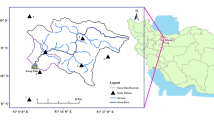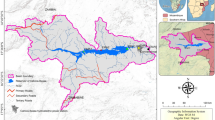Abstract
The estimation of river run-off is a complex process, but it is of vital importance to the proper operation of reservoirs, the design of hydraulic structures, flood control, drought management and the supply of water and electricity. The high uncertainty in rainfall–run-off modelling and lack of data has made the development of rainfall–run-off models with acceptable levels of accuracy and precision challenging. Furthermore, the rainfall–run-off models commonly do not provide an explicit relationship between run-off and other variables to be used for run-off-related investigations. To overcome the knowledge and information shortage in rainfall–run-off modelling, data-driven models have been used instead of conceptual models for the development of rainfall–run-off models. In this paper, three data-driven models, the genetic algorithm-support vector regression (GA-SVR), genetic algorithm-artificial neural network (GA-ANN) and the group method of data handling (GMDH) have been used to predict the monthly run-off of the Gavehroud basin. Their performances are compared with a conceptual hydrological model (HYMOD) whose parameters are calibrated using the GA. To this end, the monthly data on precipitation, temperature and run-off at the Gavehroud basin over 49 yr (1960–2009) were analysed. Evaluation of the results using performance evaluation indicators showed that the hybrid model of GA-SVR provided better accuracy in predicting the nonlinear behaviour of flow data than the GA-ANN, GMDH and HYMOD.









Similar content being viewed by others
References
Asefa T, Kemblowski M, McKee M and Khalil A 2006 Multi-time scale stream flow predictions: The support vector machines approach; J. Hydrol. 318(1) 7–16.
Badyalina B and Shabri A 2015 Flood estimation at ungauged sites using group method of data handling in Peninsular Malaysia; J. Teknologi. 76(1) 373–380.
Boyle D P 2001 Multicriteria calibration of hydrologic models; The University of Arizona Publisher, USA, chapter 4, pp. 95–122.
Bray M and Han D 2004 Identification of support vector machines for runoff modelling; J. Hydroinform. 6(4) 265–280.
Chang F J and Hwang Y Y 1999 A self-organization algorithm for real-time flood forecast; Hydrol. Process. 13(2) 123–138.
Cheng C T, Niu W J, Feng Z K, Shen J J and Chau K W 2015a Daily reservoir runoff forecasting method using artificial neural network based on quantum-behaved particle swarm optimization; Water (Basel) 7(8) 4232–4246.
Cheng C T, Feng Z K, Niu W J and Liao S L 2015b Heuristic methods for reservoir monthly inflow forecasting: A case study of Xinfengjiang reservoir in pearl river, China; Water (Basel) 7(8) 4477–4495.
Choy K and Chan C W 2003 Modelling of river discharges and rainfall using radial basis function networks based on support vector regression; Int. J. Syst. Sci. 34(14–15) 763–773.
Dibike Y B, Velickov S, Solomatine D and Abbott M B 2001 Model induction with support vector machines: Introduction and applications; J. Comput. Civil Eng. 15(3) 208–216.
Gao G Y and Jiang G P 2011 Zero-bit watermarking resisting geometric attacks based on composite-chaos optimized SVR model; J. China Univ. Post. Telecomm. 18(2) 94–101.
Guo J, Zhou J, Zou Q, Liu Y and Song L 2013 A novel multi-objective shuffled complex differential evolution algorithm with application to hydrological model parameter optimization; Water Resour. Manag. 27(8) 2923–2946.
Holland J H 1975 Adaptation in natural and artificial systems; University of Michigan Press, Michigan, USA.
Ishak A M, Remesan R, Srivastava P K, Islam T and Han D 2013 Error correction modelling of wind speed through hydro-meteorological parameters and mesoscale model: A hybrid approach; Water Resour. Manag. 27(1) 1–23.
Ivakhnenko A 1971 Polynomial theory of complex systems; IEEE Trans. Syst. Man Cybern. SMC-1 (4) 364–378.
Khadam I M and Kaluarachchi J J 2004 Use of soft information to describe the relative uncertainty of calibration data in hydrologic models; Water Resour. Res. 40(11) W11505, https://doi.org/10.1029/2003WR002939.
Kisi O and Cimen M 2011 A wavelet-support vector machine conjunction model for monthly streamflow forecasting; J. Hydrol. 399(1) 132–140.
Lin G F, Chen G R, Huang P Y and Chou Y C 2009 Support vector machine-based models for hourly reservoir inflow forecasting during typhoon-warning periods; J. Hydrol. 372(1) 17–29.
Liong S Y and Sivapragasam C 2002 Flood stage forecasting with support vector machines; J. Am. Water Resour. Assoc. 38(1) 173–186.
Moore R 1985 The probability-distributed principle and runoff production at point and basin scales; Hydrol. Sci. J. 30(2) 273–297.
Moriasi D N, Arnold J G, Van Liew M W, Bingner R L, Harmel R D and Veith T L 2007 Model evaluation guidelines for systematic quantification of accuracy in watershed simulations; Trans. ASABE 50(3) 885–900.
Muller J and Ivakhnenko A 1996 Self-organizing modelling in analysis and prediction of stock market; In: Proceedings of the second international conference on application of fuzzy systems and soft computing–ICAFS \(^{\prime }96\), Siegen, Germany, pp. 491–500.
Noori R, Karbassi A, Moghaddamnia A, Han D, Zokaei-Ashtiani M, Farokhnia A and Gousheh M G 2011 Assessment of input variables determination on the SVM model performance using PCA, gamma test, and forward selection techniques for monthly stream flow prediction; J. Hydrol. 401(3) 177–189.
Rumelhart D E, Hinton G E and Williams R J 1985 Learning internal representations by error propagation; In: Parallel distributed processing. Explorations in the microstructure of cognition, Vol 1, Foundations, The MIT Press, Cambridge, Massachusetts, USA, pp. 318–362.
Samsudin R, Saad P and Shabri A 2011 A hybrid GMDH and least squares support vector machines in time series forecasting; Neural Netw. World 21(3) 251.
Sedki A, Ouazar D and El Mazoudi E 2009 Evolving neural network using real coded genetic algorithm for daily rainfall–runoff forecasting; Expert Syst. Appl. 36(3) 4523–4527.
Singh S K and Bárdossy A 2015 Hydrological model calibration by sequential replacement of weak parameter sets using depth function; Hydrology 2(2) 69–92.
Srivastava P K, Han D, Ramirez M R and Islam T 2013 Machine learning techniques for downscaling SMOS satellite soil moisture using MODIS land surface temperature for hydrological application; Water Resour. Manag. 27(8) 3127–3144.
Su J, Wang X, Zhao S, Chen B, Li C and Yang Z 2015 A structurally simplified hybrid model of genetic algorithm and support vector machine for prediction of chlorophyll a in reservoirs; Water (Basel) 7(4) 1610–1627.
Sudheer C, Maheswaran R, Panigrahi B K and Mathur S 2014 A hybrid SVM-PSO model for forecasting monthly streamflow; Neural Comput. Appl. 24(6) 1381–1389.
Vapnik V, Golowich S E and Smola A 1997 Support vector method for function approximation, regression estimation, and signal processing; In: Advances in Neural Information Processing Systems 9, (eds) Mozer M, Jordan M I and Petsche T, Cambridge, MA: MIT Press, 1996, pp. 281–287.
Vrugt J A, Ter Braak C J, Clark M P, Hyman J M and Robinson B A 2008 Treatment of input uncertainty in hydrologic modeling: Doing hydrology backward with Markov chain Monte Carlo simulation; Water Resour. Res. 44(12) W00B09, https://doi.org/10.1029/2007WR006720.
Wang Y, Guo S, Xiong L, Liu P and Liu D 2015 Daily runoff forecasting model based on ANN and data preprocessing techniques; Water (Basel) 7(8) 4144–4160.
Wu C H, Tzeng G H and Lin R H 2009 A novel hybrid genetic algorithm for kernel function and parameter optimization in support vector regression; Expert Syst. Appl. 36(3) 4725–4735.
Yu X, Liong S Y and Babovic V 2004 EC-SVM approach for real-time hydrologic forecasting; J. Hydroinform. 6(3) 209–223.
Zhu S, Zhou J, Ye L and Meng C 2016 Streamflow estimation by support vector machine coupled with different methods of time series decomposition in the upper reaches of Yangtze river, China; Environ. Earth Sci. 75(6) 1–12.
Acknowledgements
This study was supported by Islamic Azad University, Kermanshah Branch, Kermanshah, Iran.
Author information
Authors and Affiliations
Corresponding author
Additional information
Corresponding Editor: Prashant K Srivastava
Rights and permissions
About this article
Cite this article
Yaghoubi, B., Hosseini, S.A. & Nazif, S. Monthly prediction of streamflow using data-driven models. J Earth Syst Sci 128, 141 (2019). https://doi.org/10.1007/s12040-019-1170-1
Received:
Revised:
Accepted:
Published:
DOI: https://doi.org/10.1007/s12040-019-1170-1




